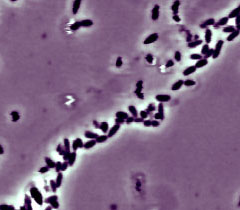Burkholderia
|
NCBI: |

Classification
Higher order taxa:
Bacteria; Proteobacteria; Betaproteobacteria; Burkholderiales; Burkholderiaceae
Species:
Burkholderia andropogonis; Burkholderia brasilensis; Burkholderia caledonica; Burkholderia caribensis; Burkholderia caryophylli; Burkholderia fungorum; Burkholderia gladioli; Burkholderia glathei; Burkholderia glumae; Burkholderia graminis; Burkholderia hospita; Burkholderia kururiensis; Burkholderia mallei; Burkholderia phenazinium; Burkholderia phymatum; Burkholderia phytofirmans; Burkholderia plantarii; Burkholderia sacchari; Burkholderia singaporensis; Burkholderia sordidicola; Burkholderia symbiont of Asellus aquaticus; Burkholderia terricola; Burkholderia tropica; Burkholderia tuberum; Burkholderia ubonensis; Burkholderia unamae; Burkholderia xenovorans; Burkholderia sp.; Burkholderia cepacia complex: Burkholderia ambifaria; Burkholderia anthina; Burkholderia cenocepacia; Burkholderia cepacia; Burkholderia dolosa; Burkholderia multivorans; Burkholderia pyrrocinia; Burkholderia stabilis; Burkholderia vietnamiensis'' ==Description and Significance== ''Burkholderia'' bacteria are both human and plant pathogens as well as environmentally important bacteria. ''Burkholderia fungorum ''strain LB400 and other closely related ''Burkhoderia'' strains are good biodegraders of polychlorinated biphenyls (PCBs) with "unparalleled ability to destroy environmentally important PCB congeners" (DOE). Conversely, ''Burkholderia pseudomallei'' is the causative agent of melioidosis, as disease that harms both humans and animals, as well as septicemia and pneumonia in susceptible individuals (Godoy et al. 2003). ==Genome Structure== ''Burkholderia fungorum ''is presently being sequenced by the DOE Joint Genome Institute. It has three large replicons (chromosomes) and a megaplasmid with a total of 8.1 Mb. Apparently, the large size of genomic material, which is among the larges of the soil bacteria known, may contribute to its "ecological success." Because this and related PCB-degrading bacteria have such important ecological and commerical potential for bioremediation technologies, sequencing this genome will be extremely important in shedding light on the mechanisms and organization responsible for the group's metabolic and environmental versatility. This knowledge will allow new development of "novel environmental remediation technologies and products for plant growth promotion" (DOE). ==Cell Structure and Metabolism== ''Burkholderia'' bacteria are rod-shaped, motile, Gram-negative bacteria that are capable of both pathogenic characteristics and degrading PCBs. The bacteria are also generally obligately aerobic. Of the bacterial isolates found in the Arctic that are able to degrade PCBs, none used compounds such as 2-chlorobiphenyl, 3-chlorobiphenyl, camphor, citronellol, cymene, dehydroabietic acid, limonene, methanol,'' n''-hexadecane, pentachlorophenol, phenol, or pinene as primary growth substrates (Master and Mohn 1998). ==Ecology== ''Burkholderia'' bacteria are commonly found in the soil and in groundwater worldwide. Burkholderia and related bacteria have been found at soils of all tempuratures including Arctic soil of 7<sup>o</sup>C. ==Pathology== [[Image:nasal_septum.jpg]] A removed nasal septum of a horse showing different stages of lesions caused by glanders. First, a nodule develops and then ulcerates. It then heals by granulation which leads to cicatrisation and is left as stellate scars. From [http://vein.library.usyd.edu.au/links/exoticdiseases/glanders.html VEIN] [[Image:horse_leg.jpg]] Lymphadenitis and lymphangitis that has ulcerated to this horse's skin - this is refered to as farcy. From [http://vein.library.usyd.edu.au/links/exoticdiseases/glanders.html VEIN ] ''Burkholderia pseudomallei ''is generally considered a saprophyte (grows on and uses dead or decaying organic matter as an energy source), it also causes the infectious disease melioidosis that is mostly restricted to Southeast Asia, northern Australia, and some other tropical and subtropical regions. It also occasionally causes serious invasive diseases like septicemia and pneumonia in susceptible individuals. Although the epidemiology of melioidosis is not yet fully understood, it is thought that infections are contracted by contact with the organism from contaminated ground water ("for example, in rice paddies") through puncture wounds, cuts, or abrasions in the skin (Godoy ''et al.'' 2003). ''Burkholderia mallei'', which is very closely related to ''B. pseudomallei'', causes glanders in horses and other equines and occasionally in humans and other animals. This disease is generally found in parts of Africa, Asia, the Middle East, and Central and South America. The human'' B. mallei'' infection is very close to an infection of ''B. pseudomallei ''(Godoy et al. 2003). In horses, the bacterial acute infection causes the development of "rapidly spreading ulcers in skin and nasal mucosa" as well as "death within a few days from septicaemia" (VEIN). The chronic disease caused by ''B. mallei'', which is more common, results in lesions and pulmonary involvement. It can manifest in nasal form, skin form, or both nasal and skin form at the same time. Both of ''B. mallei'' and ''B. pseudomallei'' are considered potential agents of biological warfare or bioterrorism -- CDC lists them in category B of the list of bioterrorism agents (Godoy'' et al.'' 2003) . In addition to all this, ''Burkholderia cepacia'' is a pathogen associated with chronic lung disease in cystic fibrosis patients (Kiska ''et al.'' 1995). ==References== ===General:=== * DOE Joint Genome Institute: [http://genome.jgi-psf.org/draft_microbes/burfu/burfu.home.html ''Burkholderia fungorum''] * Godoy, Daniel, Gaynor Randle, Andrew J. Simpson, David M. Aanensen, Tyrone L. Pitt, Reimi Kinoshita, and Brian G. Spratt. 2003. "Multilocus sequence typing and evolutionary relationships among the causative agents of melioidosis and glanders, ''Burkholderia pseudomallei ''and ''Burkholderia mallei''." Journal of Clinical Microbiology, vol. 41, no. 5. American Society for Microbiology. (2068-2079) * Master, Emma R. and William W. Mohn. 1998. "Psychrotolerant bacteria isolated from Arctic soil that degrade polychlorinated biphenyls at low tempuratures." Applied and Environmental Microbiology, vol. 64, no. 12. American Society for Microbiology. (4823-4829) ===Pathology=== * Veterinary Education and Information Network: Exotic Diseases: Dermatolotical Diseases: [http://vein.library.usyd.edu.au/links/exoticdiseases/glanders.html Glanders]
